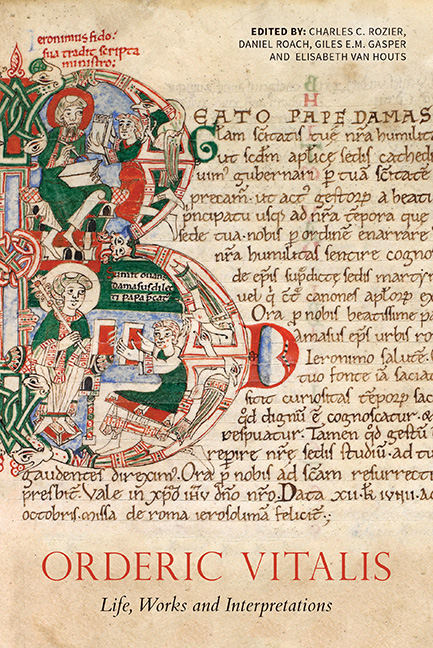Book contents
- Frontmatter
- Dedication
- Contents
- List of Illustrations
- Acknowledgements
- List of Abbreviations
- Chronology of the Lives of Odelerius and his Son Orderic Vitalis
- Composition of the Historia ecclesiastica
- Introduction: Interpreting Orderic Vitalis
- Orderic and his Father, Odelerius
- Following the Master's Lead: The Script of Orderic Vitalis and the Discovery of a New Manuscript (Rouen, BM, 540)
- Orderic Vitalis as Librarian and Cantor of Saint-Évroul
- Saint-Évroul and Southern Italy in Orderic's Historia ecclesiastica
- Orderic and English
- Inscriptions in Orderic's Historia ecclesiastica: A Writing Technique between History and Poetry
- Reading Orderic with Charters in Mind
- Orderic Vitalis and the Cult of Saints
- Orderic's Secular Rulers and Representations of Personality and Power in the Historia ecclesiastica
- Worldly Woe and Heavenly Joy: The Tone of the Historia ecclesiastica
- Orderic Vitalis, Historical Writing and a Theology of Reckoning
- Jesus Christ, a Protagonist of Anglo-Norman History? History and Theology in Orderic Vitalis's Historia ecclesiastica
- ‘Studiosi abdita investigant’: Orderic Vitalis and the Mystical Morals of History
- Meanders, Loops, and Dead Ends: Literary Form and the Common Life in Orderic's Historia ecclesiastica
- Orderic and the Tironensians
- ‘One single letter remained in excess of all his sins …’: Orderic Vitalis and Cultural Memory
- The Reception of Orderic Vitalis in the Later Middle Ages
- Appendix 1 Archaeological Investigations at the Abbey of Saint-Évroult-Notre-Dame-des-Bois
- Appendix 2 Descriptive Catalogue of Manuscripts Featuring the Hand of Orderic Vitalis
- Select Bibliography
- List of Manuscripts Cited
- General Index
The Reception of Orderic Vitalis in the Later Middle Ages
Published online by Cambridge University Press: 25 October 2017
- Frontmatter
- Dedication
- Contents
- List of Illustrations
- Acknowledgements
- List of Abbreviations
- Chronology of the Lives of Odelerius and his Son Orderic Vitalis
- Composition of the Historia ecclesiastica
- Introduction: Interpreting Orderic Vitalis
- Orderic and his Father, Odelerius
- Following the Master's Lead: The Script of Orderic Vitalis and the Discovery of a New Manuscript (Rouen, BM, 540)
- Orderic Vitalis as Librarian and Cantor of Saint-Évroul
- Saint-Évroul and Southern Italy in Orderic's Historia ecclesiastica
- Orderic and English
- Inscriptions in Orderic's Historia ecclesiastica: A Writing Technique between History and Poetry
- Reading Orderic with Charters in Mind
- Orderic Vitalis and the Cult of Saints
- Orderic's Secular Rulers and Representations of Personality and Power in the Historia ecclesiastica
- Worldly Woe and Heavenly Joy: The Tone of the Historia ecclesiastica
- Orderic Vitalis, Historical Writing and a Theology of Reckoning
- Jesus Christ, a Protagonist of Anglo-Norman History? History and Theology in Orderic Vitalis's Historia ecclesiastica
- ‘Studiosi abdita investigant’: Orderic Vitalis and the Mystical Morals of History
- Meanders, Loops, and Dead Ends: Literary Form and the Common Life in Orderic's Historia ecclesiastica
- Orderic and the Tironensians
- ‘One single letter remained in excess of all his sins …’: Orderic Vitalis and Cultural Memory
- The Reception of Orderic Vitalis in the Later Middle Ages
- Appendix 1 Archaeological Investigations at the Abbey of Saint-Évroult-Notre-Dame-des-Bois
- Appendix 2 Descriptive Catalogue of Manuscripts Featuring the Hand of Orderic Vitalis
- Select Bibliography
- List of Manuscripts Cited
- General Index
Summary
Caen, 14 August 1417: three hundred and thirty years since, as Orderic Vitalis memorably described, the presence of a king of England (or, rather, of his mortal remains) had endangered the abbey of Saint-Étienne. Now the convent had reason to fear the proximity of another monarch from across the Channel, this time very much alive. The thirty-year-old invader Henry of Monmouth (Henry V) was approaching the town, and its defending garrison was undertaking the desperate work of laying waste its environs. Meanwhile, the vanguard, under the king's second brother, Thomas, duke of Clarence, set camp and weighed the prospects for the siege-battle to come. Long after nightfall – perhaps only shortly before matins, given the season – a hooded figure stole from the precinct wall (whose fortifications had only recently been renewed), heading for the tents of the attackers. A monk of Saint-Étienne, whose name is remembered as Gérard, entered the tent of the young prince (which would have been clearly marked), rousing him with valuable intelligence and a heartfelt plea. The defenders had determined to destroy the abbey rather than to see it serve as a portal for the invasion force, and Brother Gérard had taken it upon himself to give up Saint-Étienne to the English if in turn the church might be saved:
humbly and tearfully [he] pleaded […] It has fallen especially to you to save our monastery, to you who [are] descended from the line of kings who founded, built and endowed this place of ours.
Clarence, a commander who matched Orderic's image of a knight of ‘great enterprise’ and ‘quick wits’ in the field and (like his elder brother) was as well schooled in his forbears’ histories as were those Norman archetypes, recognised the opportunity perhaps as much for its propaganda as its tactical potential. His troops entered the abbey and turned it into their campaign headquarters. King Henry was welcomed there four days later. And from its towers, the English artillery was trained on the town.
Gérard's great hope for Saint-Étienne was not quite realised. The church was damaged by the blasting of the English bombards.
- Type
- Chapter
- Information
- Orderic Vitalis: Life, Works and Interpretations , pp. 352 - 374Publisher: Boydell & BrewerPrint publication year: 2016



